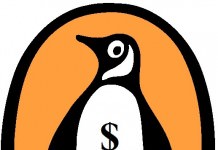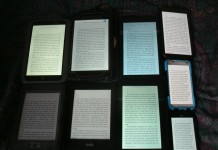 Since the Wall Street Journal is subscription only I can’t get at the article, but the Bookseller has a good summary of this interview with the CEO of Penguin, John Makinson.
Since the Wall Street Journal is subscription only I can’t get at the article, but the Bookseller has a good summary of this interview with the CEO of Penguin, John Makinson.
He calls the ebook the direct descendent of the paperback, an idea which Penguin invented.
Makinson also argued that there was limited scope to play with e-book prices and royalties, saying: “The small cost of producing ebooks is viewed by authors as an opportunity for higher royalties and by consumers as an opportunity for lower prices. Fair enough. Yet the physical cost of a book – manufacturing, transportation and warehousing – is just under 10% of its retail price. Ten per cent is also, as it happens, roughly the average margin of the consumer book publishing industry and what’s needed to keep investing in new writing and new ideas. So there’s some room for discussion but not much.”
































Ask him why some of Penguin’s books have geographical restrictions: for ex., Stieg Larrson’s & John Clare. To name but 2 authors.
Just on the issue of these “savings” estimates offered by the big publishers, we really need some hardcore economic analysis (Freakonomics guys??). Makinson is first off mixing of apples and oranges. On printed books, publishers only receive a wholesale price, a portion of which ends up as their profit to calculate the profit margin figure Makinson cites. I believe wholesale prices are about half the retail cover price. So the manufacturing costs Makinson cites are more like 20% of his costs.
And his estimate doesn’t appear to figure in returns and waste and the costs/losses from printing too many or not enough copies. That is, it may cost 10% of the cover price of each book to print it and ship and so on but not every book printed is actually sold. Collectively, figuring in the returns and waste, those manufacturing costs are going to be more than 10% (really 20%) of the publisher’s total revenue from the book. Missed sales opportunities from books going out of print etc also figure in.
Then there is the retail side of costs, which as I mentioned, is the other half of the cover price. Retailers should save quite a bit on their end as well.
And once again the “physical production cost of a book” argument conveniently avoids dealing with half the production run ending up in a landfill, which rather changes the actual cost. Nice move fudging the two 10 percent figures as well, but that doesn’t make up for the ground lost in comparing an e-book to a paperback, as that leads the consumer to expect a sane price.
I rate it a 7.5, overall.
John Makinson is absolutely correct. In the consumer eyes, the e-book is a substitute for a mass paperback — not a hard cover — and pricing ought to follow suit. Given the “permanence of paper” vs. “ephemeral nature of electrons”, one may be forgiven for believing an e-book should be priced lower relative to even a mass paperback.
That doesn’t mean the price should be free or 99¢. But if the paperback is $7.99 and is supporting bricks and mortar distribution, and many copies are stripped of the covers for credit and the books themselves tossed into landfill; surely it’s not hard to expect the e-book to be $5.99?
Also, Penguin currently produces their ebooks by reverse engineering their pbook files, which is a waste of labour. Once the eBook is created automatically from the final digital manuscript (XSLT transforms for Hard Cover, trade, mass market, ebook formats) they will save money. The current production process is not efficient.
And yes, as several people have mentioned, the 10% value does not take into consideration the cost of risk involved in paper book production. ebooks have 0 risk (beyond the first copy).
As I wrote previously (see A Modest Proposal: A 21st Century Publishing Model, http://americaneditor.wordpress.com/2010/01/08/a-21st-century-publishing-model/), the time has come for publishers to begin to publish only hardcover and ebook, scrapping the paperback. Makinson is correct that ebooks are the new paperbacks, but there is no hope that he will convince ebookers that ebooks should cost more than paperbacks and less than hardcovers until he actually does away with paperbacks. I doubt, however, that Penguin will take the lead in this area.
One other note, unless we have all missed some gargantuan change of heart by JK Rowling, there’s also something sad (or worse) about Makinson trying to make his case and starting with a mega-misstatement that’s going raise false hopes:
“His answer was the iPad, a typically alluring device, featuring a screen big enough for the comfortable reading of books, and a new iBookstore, bringing the text of Harry Potter within reach of America’s millions of iTunes users for the first time.”
I think a significant part of the problem — by no means the whole of the problem — is exactly as Makinson has noted: ebooks are the 21st century paperbacks. Consequently, it really is time for Penguin and other publishers to abandon the paperback and produce hardcover and ebooks only, as I suggested in my blog post A Modest Proposal: A 21st Century Publishing Model (http://americaneditor.wordpress.com/2010/01/08/a-21st-century-publishing-model/). As long as paperbacks continue to be published, the publisher will have a difficult, if not impossible, time trying to get ebookers to use a difference reference point for determining value.
Abandoning paperbacks in 2010 is not the solution to e-book health; they are complementary and, like radio, TV, the movies and DVD, can co-exist for a long time and be profitable in each variant.
“Yet the physical cost of a book – manufacturing, transportation and warehousing – is just under 10% of its retail price”
Great that means that 90% goes to publishers and other hangers on – Sounds like plenty of fat to cut and still reward Authors. Authors should self publish and dump the publishers. Draft in somebody else to check and edit your book.
I think there are some big disconnects with the publishers, and their true end customers the readers. First I want to note that while looking for a Pengiun authors ebook recently, I went to their web site which listed the ebook at hardcover prices when I was searching, even though the paperback was already out. In the case of this author they now will not offer the first volume in digital on their site but it can be found on various ebook sites. The other large disconnect I am seeing here is that all of these publishers are complaining that Amazon is taking all their profits. But none of the publishers seem to see the value of marketing the books directly to people through their own online storefront. Amazon is a convenient middleman, but nothing is stopping them from making a push to sell their books directly to the customers. This seems like a lost opportunity that publishers aren’t capitalizing on.
What I’d like to know is what the cost contribution is in the whole process of figuring out how to size the print run. The sales solicitation/pre-order cycle isn’t free, and that never gets figured in. What also never gets figured in is sell-through rate. If 10% of the retail price is the physical handling and the sell-through rate is 40% with 60% of the print run getting dumped or trashed, then isn’t the effective cost 25% of the retail price for the copies that actually sold? Adding in the wholesale contribution, that could mean that the publisher’s physical costs are actually half of what they take in.
The fact that the ebook doesn’t need solicitations to size a print run and 100% sell-through rate both have cost savings that don’t show up in these analyses.